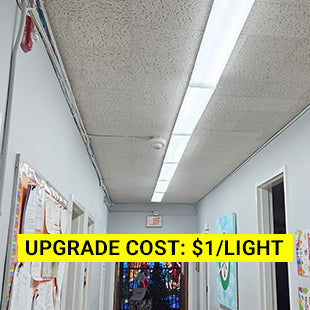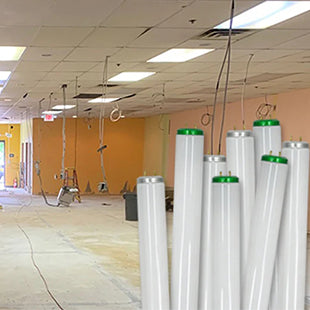Lumens: How to Compare Light Output Between Different Lighting Technologies
You know how much light to expect from a standard 4-foot fluorescent tube, but how do you determine how bright a 18-watt LED tube is? Enter lumens.
Lumens are the measure of total light intensity from a single source (in this case, a tube). The greater the lumens, the brighter or more intense the light. A 40-watt fluorescent tube, for example, is rated around 2300 lumens. To replace it with the same intensity LED, look for one that rates around 2300 lumens.
Of course, not every fluorescent, incandescent, metal halide, etc., lamp will specify its lumens.
Below is a chart to help you come to a rough calculation on your own, to make it easy to compare to LED lights (which always have a lumen value as part of their specifications). Simply multiply the average lumens per watt (also known as "luminous efficacy") for the light type of your light by the wattage of your light.
Example: Metal halide averages 87.5 lumens/Watt. A new 400W metal halide lamp would be about 35,000 lumens: 400W x 87.5 lm/W.
| Light Type | Average Typical Luminous Efficacy (lumens/watt) |
| Incandescent | 15 lm/W |
| Halogen | 20 lm/W |
| Fluorescent | 60 lm/W |
| Metal Halide | 87.5 lm/W |
| High pressure sodium | 117.5 lm/W |
| Mercury vapor | 50 lm/W |
How to Use "Luminous Efficacy" to Your Benefit.
Luminous efficacy, via the calculation of lumens/Wattage, tells you how efficiently any lamp converts power into light. The higher the efficacy, the more efficient the lamp is. With that number, you can quickly assess how much more efficient any LED light is compared to any other light.
For instance, and LED tube that operates at 120 lm/W is 100% more efficient than a fluorescent tube that operates at 60 lm/W.
It's not uncommon today to find LED lights operating at 150 lm/W or higher. Lights with efficacy as high as 200 lm/W are beginning to come to market.
So, a 180 lm/W LED tube, like our newest 8ft tubes, is 200% more efficient than a 60 lm/W fluorescent tube. It's also 50% more efficient than the 120 lm/W LED tube. If you installed one of those 120 lm/W (or lower) LED tubes several years ago, you could get your energy bills even lower by swapping out to 180 lm/W tubes today.
Moving to high-ceiling lighting, you can get a 180 lm/W LED high bay today, or even a 200 lm/W LED high bay, that's a whole lot more efficient at converting energy into light than an 87.5 lm/W metal halide or 50 lm/W mercury vapor lamp.
Shop smart, reduce your overhead, and enjoy long lamp life & low lifetime maintenance when you choose the latest in LED technology.
Shop Our Highest-Efficiency Lighting




